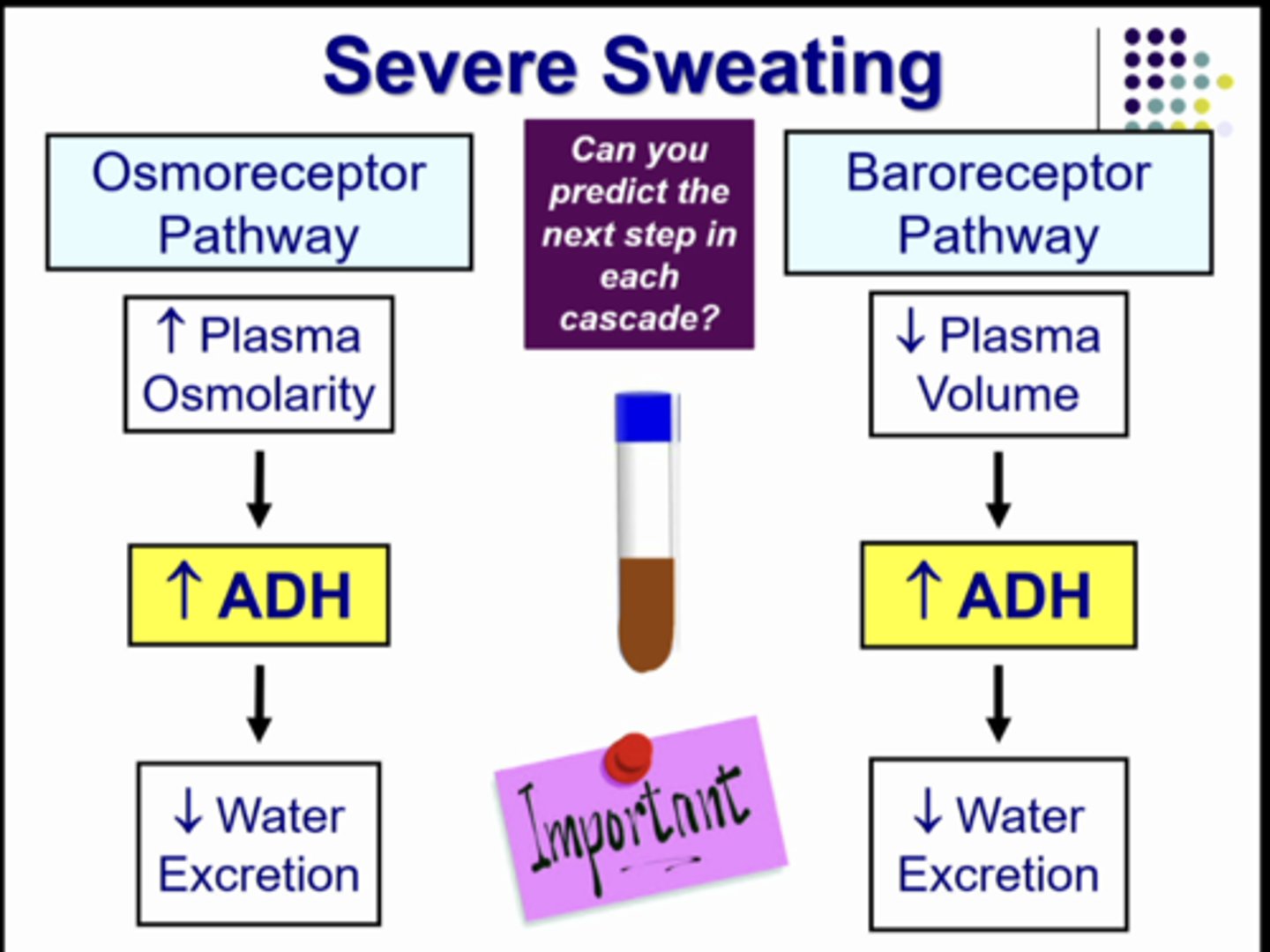renal physiology lecture: renal water balance: lecture 5
1/63
There's no tags or description
Looks like no tags are added yet.
Name | Mastery | Learn | Test | Matching | Spaced |
|---|
No study sessions yet.
64 Terms
keep these things in mind when caring for a patient with kidney disease
keep these things in mind when caring for a patient with kidney disease
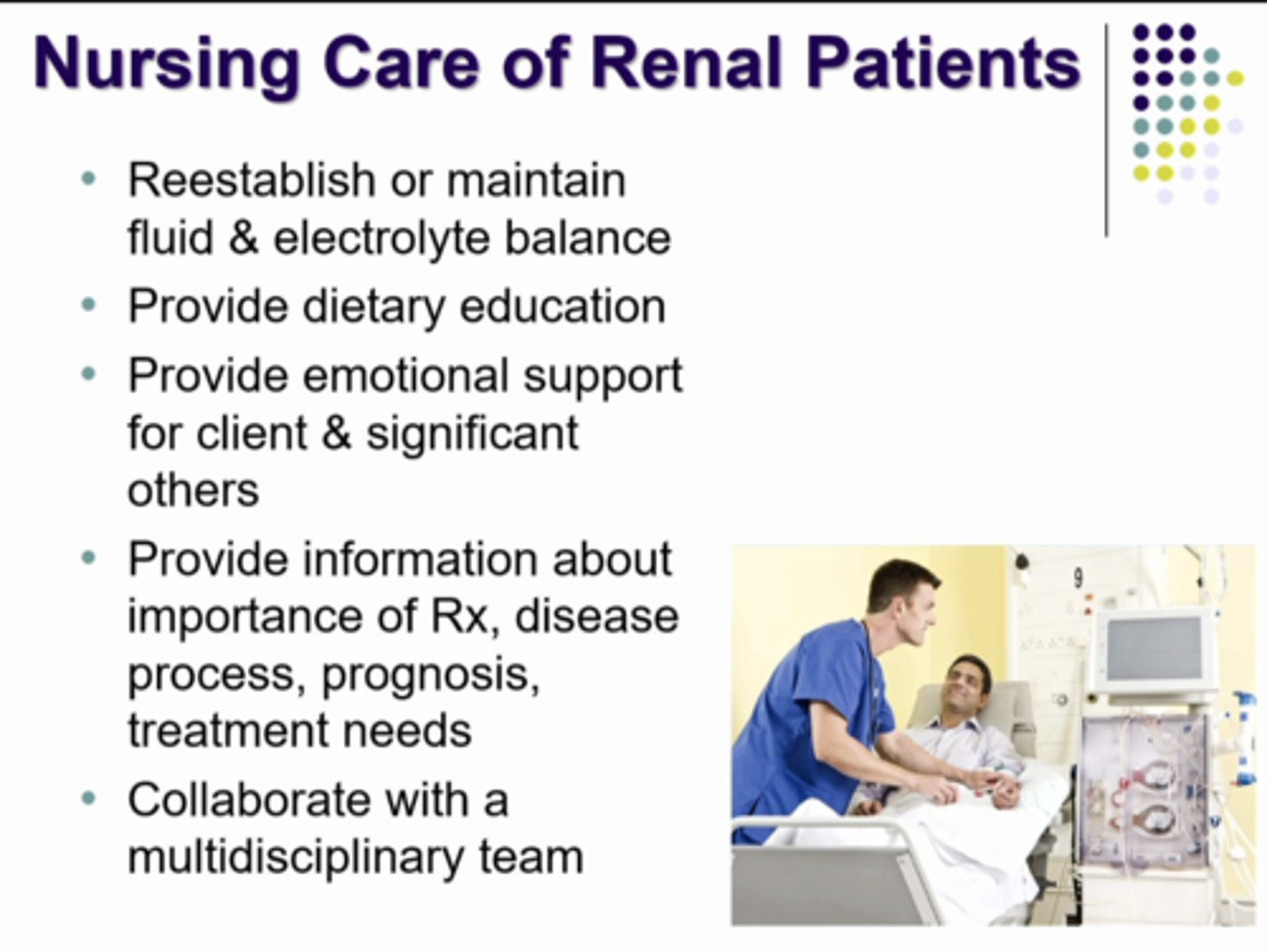
nephrologist
physician who specializes in treating patients with kidney disease
b. the substance is being filtered and secreted
an assessment of glomerular filtration studies indicates that renal clearance of a freely filtered drug (Cl D) is greater than the glomerular filtration rate (GFR). based on this finding, what man you conclude about the process occurring to the drug along the nephron?
a. the substance is being filtered only
b. the substance is being filtered and secreted
c. the substance is being filtered and partially reabsorbed
d. the substance is being filtered and completely reabsorbed
inulin
what substance is only filtered
c. in the proximal tubule, allows for secondary active counter transport of hydrogen ions and co-trasnport of glucose and amino acids
active transport of sodium:
a. occurs in all segments of the tubule and is dependent upon Na/K ATPase pumps located in the luminal (apical) membrane
b. in the proximal tubule, allows for secondary active co-transport of potassium ions and counter transport of glucose
c. in the proximal tubule, allows for secondary active counter transport of hydrogen ions and co-trasnport of glucose and amino acids
d. sodium is actively secreted by the nephron
2850ml, the same amount!!
lets say we take in 1400 ml of liquid, 1100 ml of water in the foods we eat, and 350 ml from metabolism water production.... you will get 2850ml. so in order to maintain homeostasis, you need to lose....
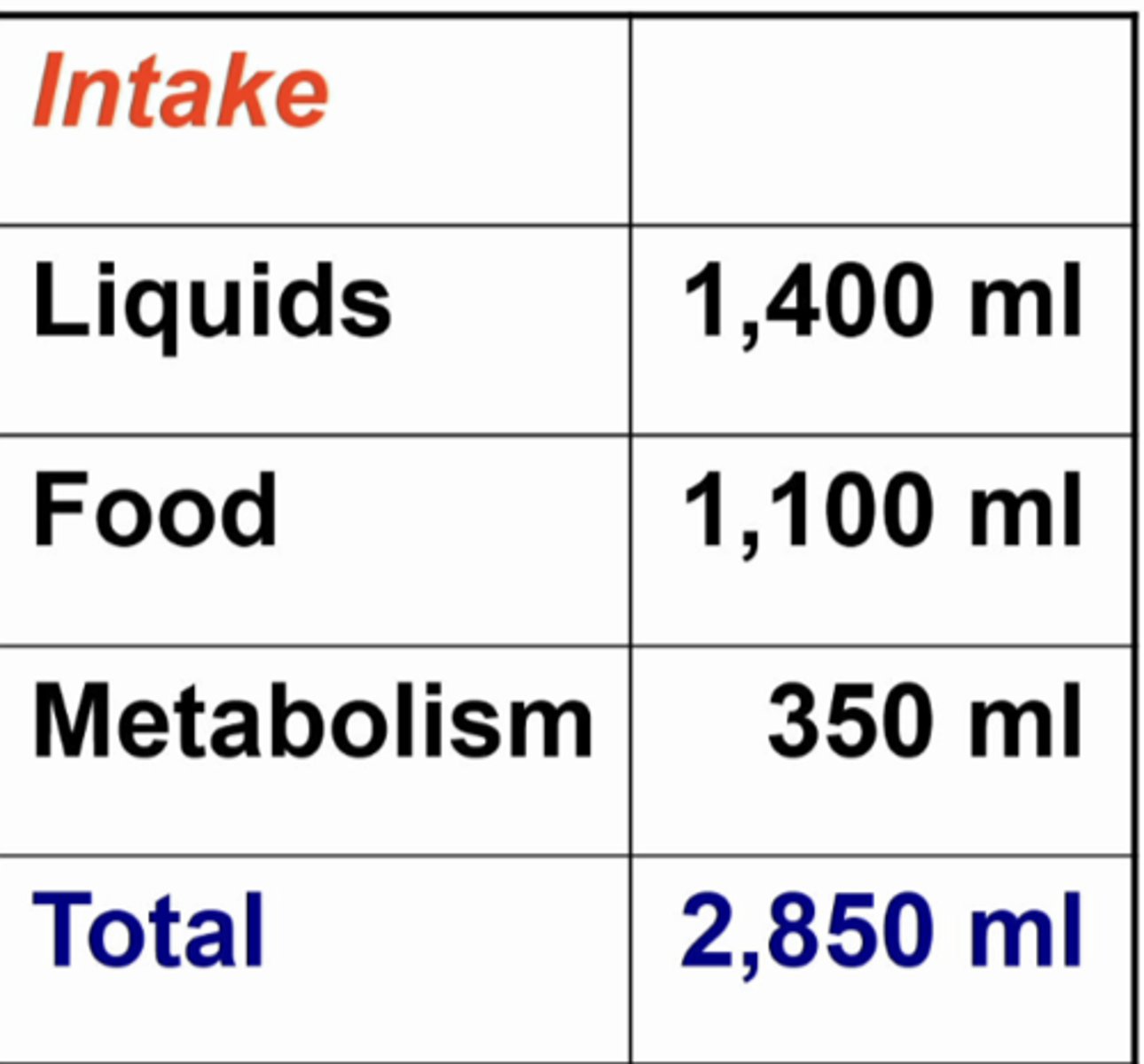
the kidneys will exactly regulate water balance
you will lose 900ml of water via insensible loss (not aware of water loss - evaporation, lungs). you will lose 50ml from sweat. you will lose 100ml from feces. you will lose 1800ml from urine. so in total, you lose 2850 ml per day because...
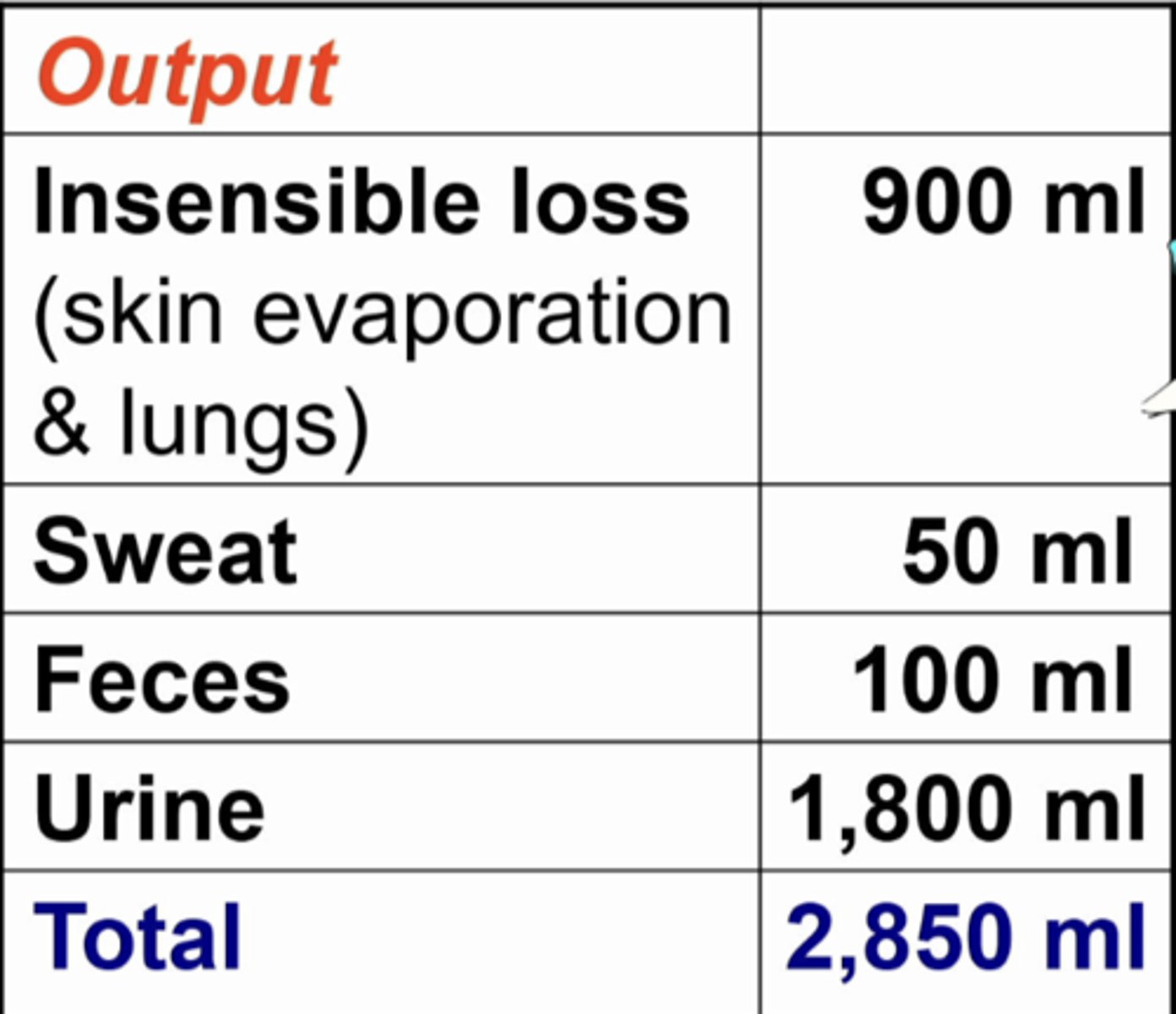
summary of the past 2 cards
summary of the past 2 cards
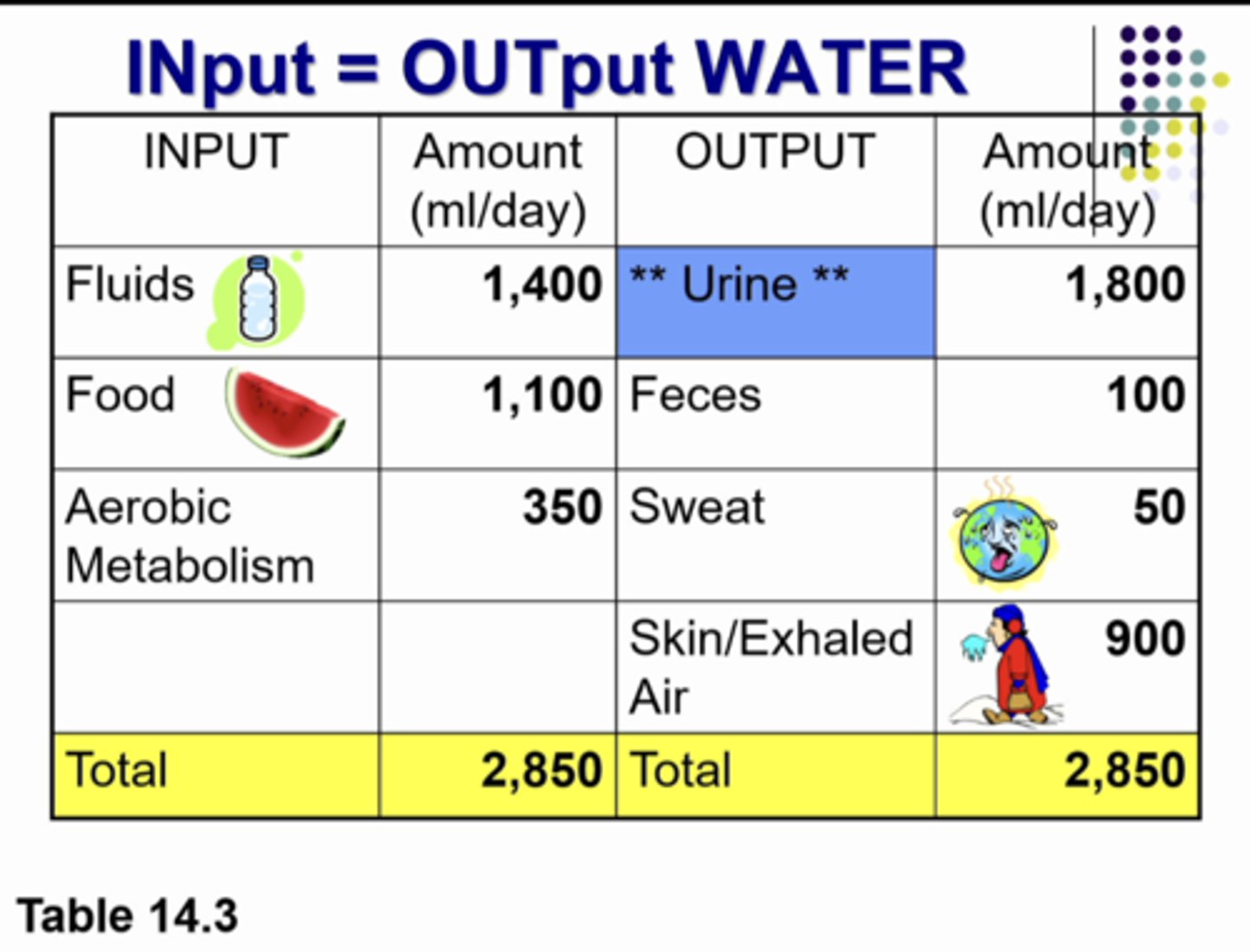
we are now going to embark on prolonged heavy exercise. preparing for a half marathon, going on a 10 mile jog. if the output of water normally when we are in the air conditioning is on the left... if we undergo heavy exercise... notice how much fluid is being loss by the body from skin and sweat. notice also there is a greater loss of fluid from the lungs because of increased ventilation. so the body will decrease the urine output since there is a lot of water loss everywhere else. in order to maintain water balance, we need to drink more water!!!
what is this image showing

600 mosmol/d
kidneys must excrete solute load to body about...
-the kidneys can do this by producing urine that has a osmolarity as low as 50 and as high as 1200 mOsm/kg H2O
urine color and its meaning
urine color and its meaning

as low as 0.5L/d or as high as 18 L/d
the volume of water that the kidneys can excrete can be...
independently
kidneys control H20 excretion ________________ of Na+, K+, urea
**very important - kidney is so special
solutes, water
critical ability to vary relative proportions of _________ and __________ in order to maintain homeostasis
arginine vasopressin
what is another name for antidiuretic hormone?
diuresis
urine flow above usual levels
antidiuresis
low rate of water excretion (<0.5ml/min) as hyperosmotic urine
normal
__________ urine flow = 1ml/min
we are in the proximal tubule. the tubular fluid is on the left as well as the luminal membrane. the blood side is on the right. water will move easily through the luminal and basolateral membrane of the proximal tubule via aquaporin 1. the plasma membrane is a bilipid layer made of fat and water does not easily pass fat so there needs to be pores to facilitate rapid water reabsorption. there is a little bit of water reabsorption via the paracellular route with water moving through the tight junctions. remember the aquaporins are always open because they are pores
what is this image showing
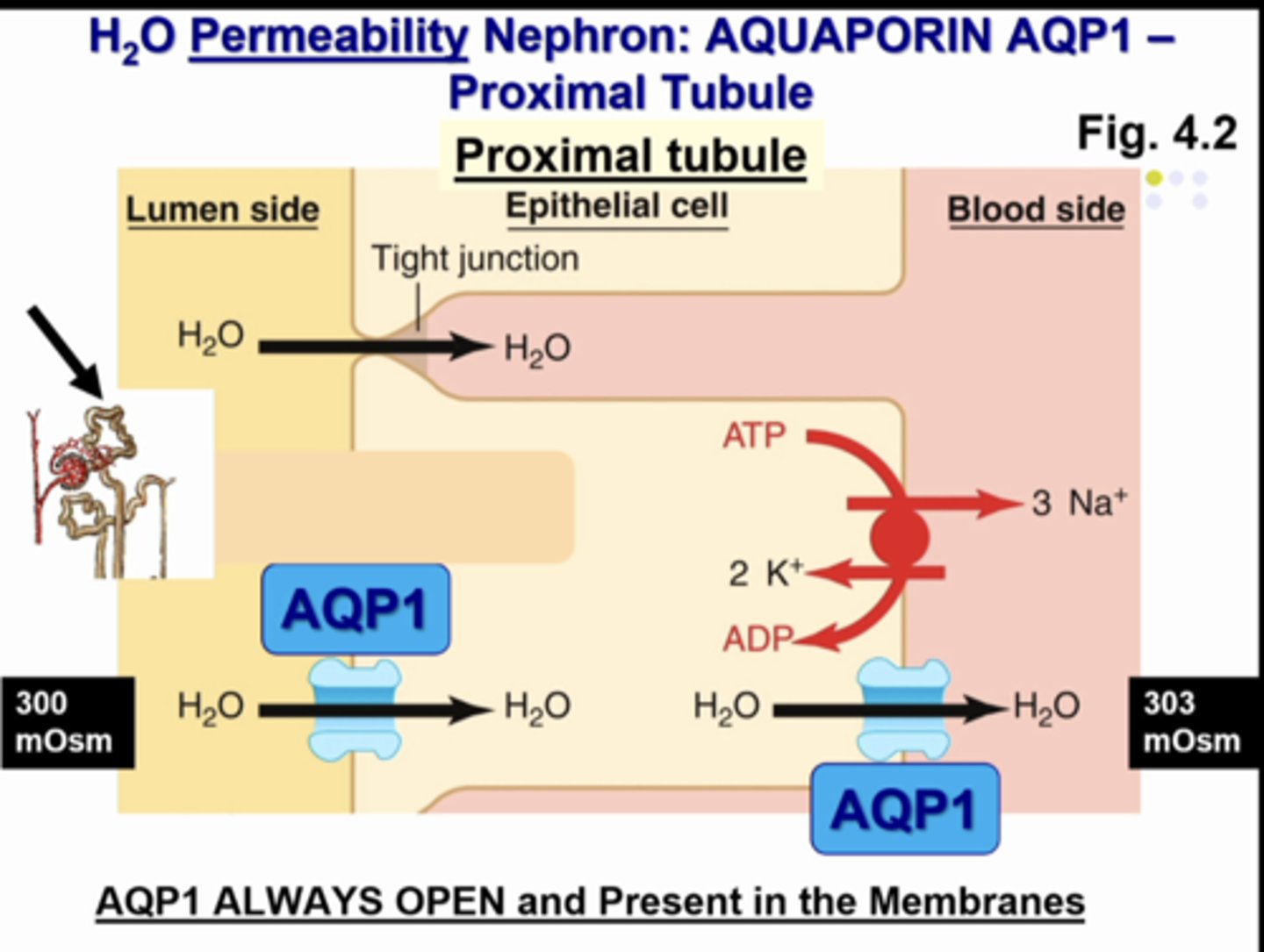
1. proximal tubule
2. thin descending limb of henle
water permeability of the nephron !!!
if antidiuretic hormone is ABSENT........ the only structures that are water permeable are ......
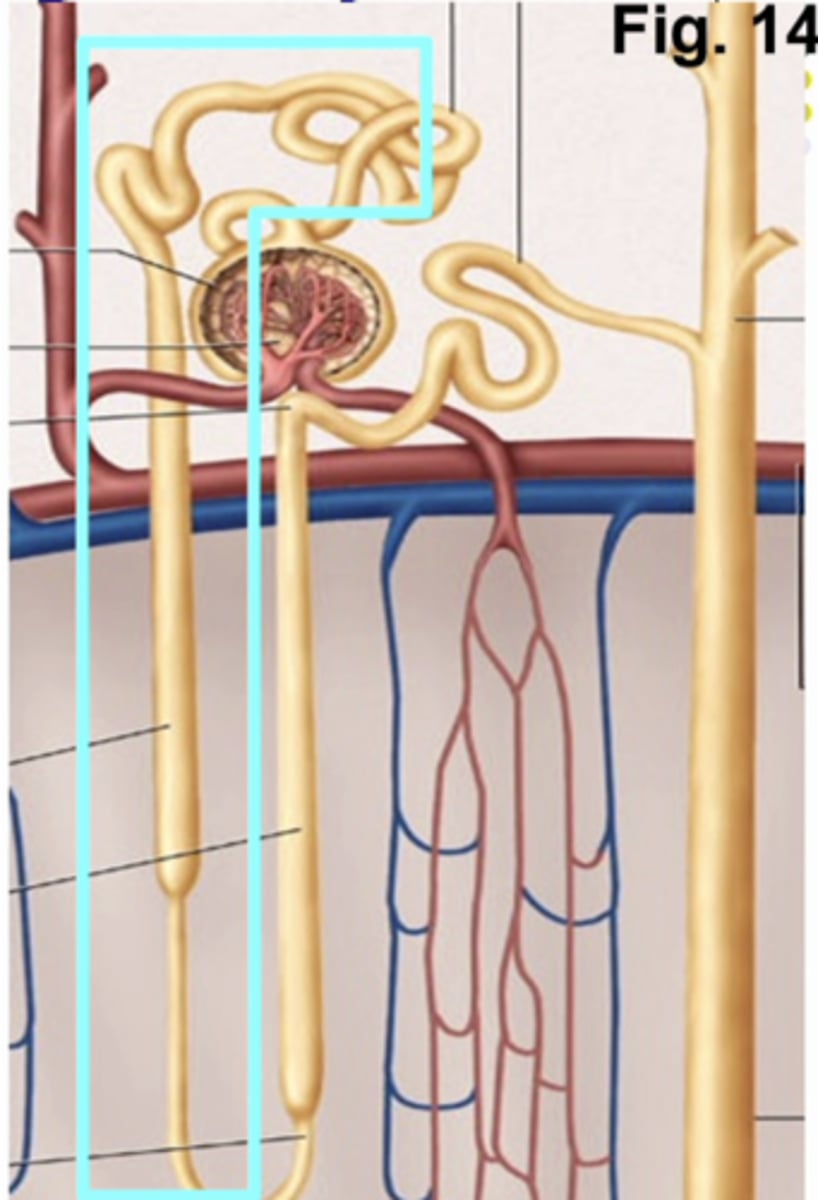
1. thick ascending limb of henle
2. distal tubule
3. collecting duct *
water permeability of the nephron !!!
if antidiuretic hormone is ABSENT........ the structures that are water impermeable are ......
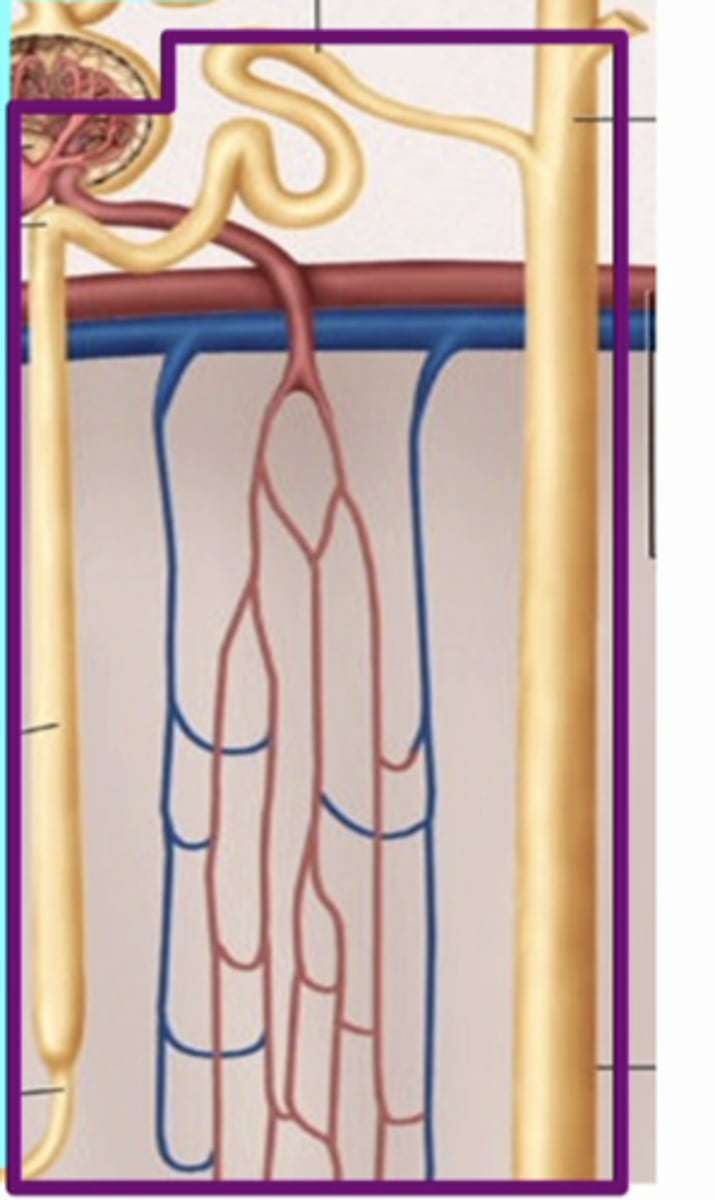
1. proximal tubule
2. thin descending limb of henle
3. collecting duct *
water permeability of the nephron !!!
if antidiuretic hormone is PRESENT........ the structures that are water permeable are ......
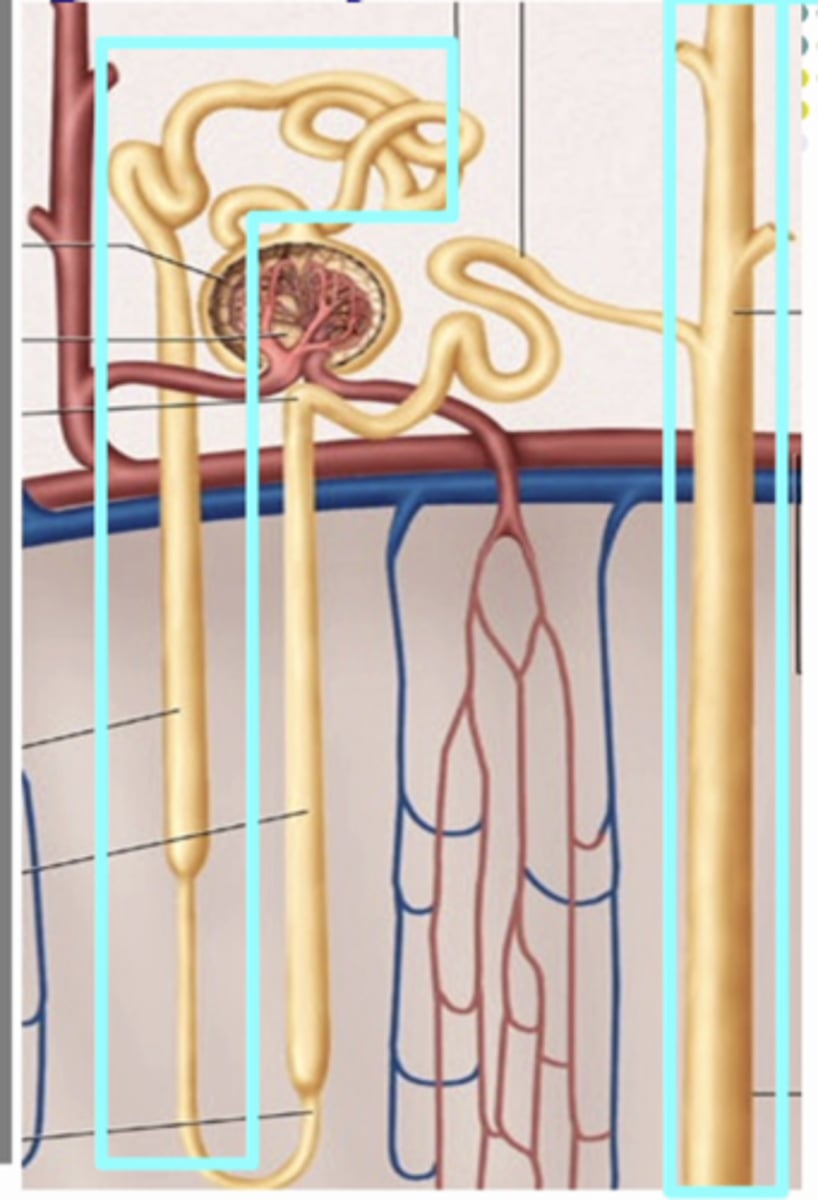
1. thick ascending limb of henle
2. distal tubule
water permeability of the nephron !!!
if antidiuretic hormone is PRESENT........ the structures that are water impermeable are ......
proximal tubule and think descending limb of henle
which two structures are always water permeable no matter if the ADH is present or not?
thick ascending limb of henle and distal tubule
which two structures are always water impermeable no matter if the ADH is present or not?
hypo-osmotic - less than 300mosmol
hyper-osmotic - greater than 300mosmol
what is the difference between hypoosmotic urine and hyperosmotic urine? which is more concentrated? which is more dilute? RELATIVE TO PLASMA OSMOLALITY
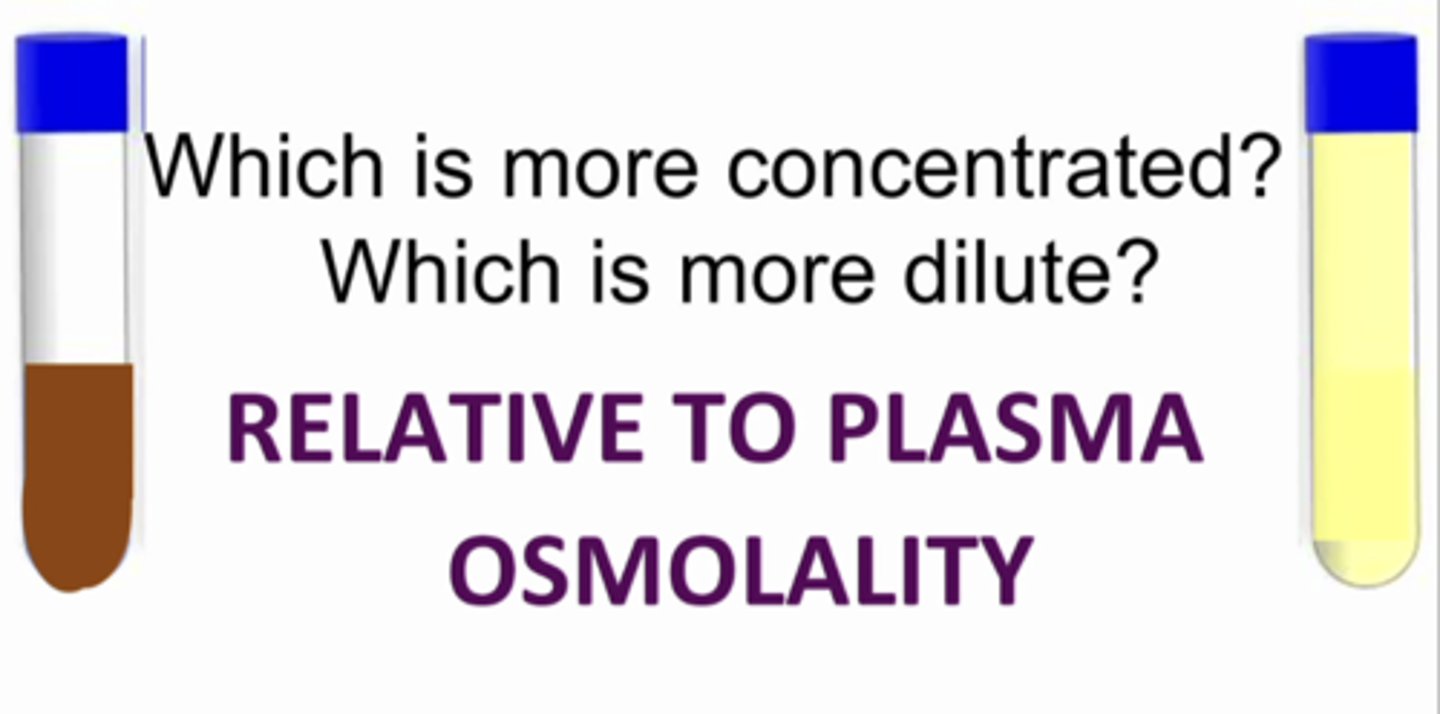
300 mOsm
kidneys maintain plasma osmolarity at ...
countercurrent flow
fluid in 1 tube flows in opposite direction to 2nd tube
-greatly increases opportunity for exchange of H2O and solutes
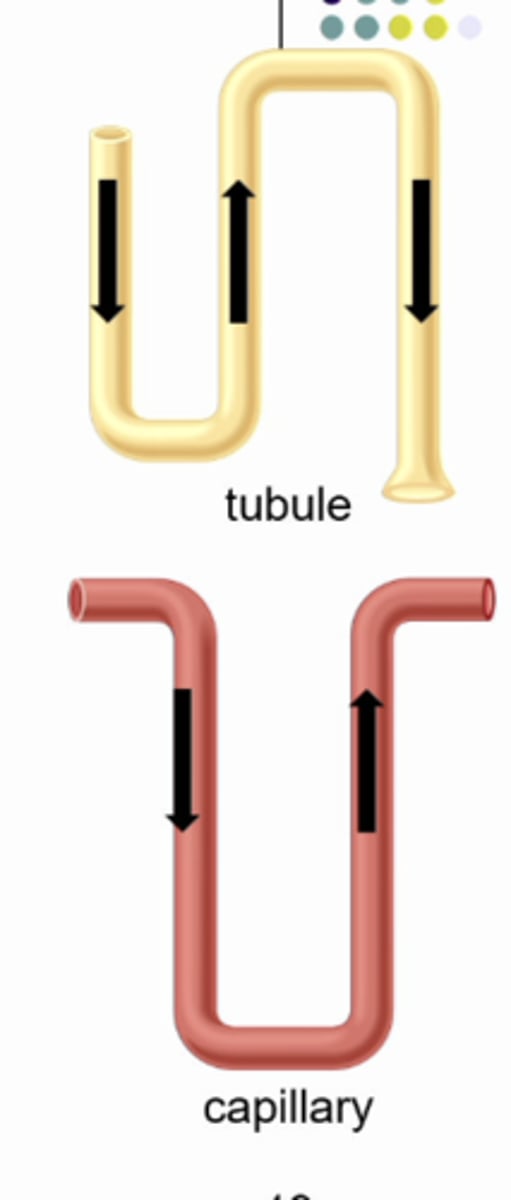
1. loop of henle: tubule: hairpin loop
2. vasa recta: capillary: hairpin loop
3. hypertonic medullary interstitium
4. antidiuretic hormone: ADH=AVP
what are the requirements for production of concentrated urine: countercurrent system?
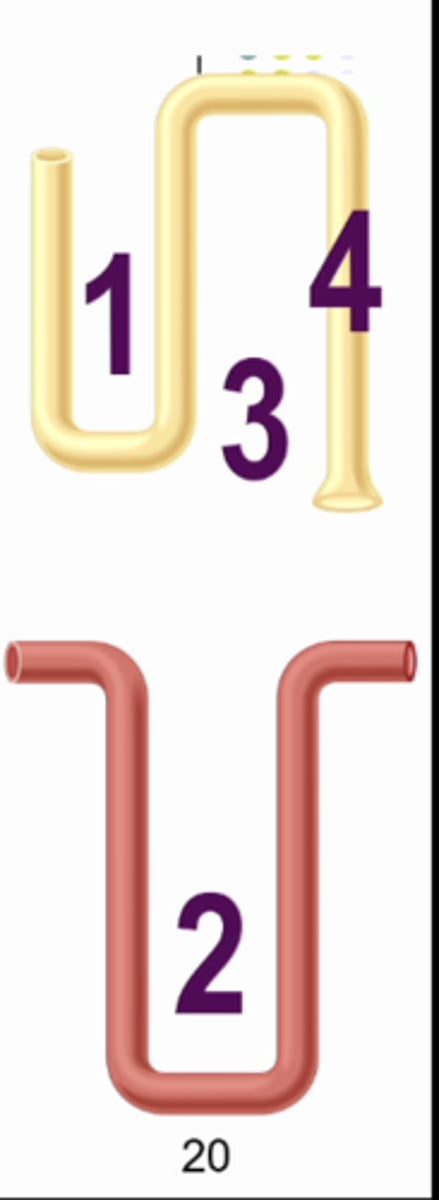
1. thin descending = permeable water, NOT solute
2. thick ascending limb = permeable solute, NOT water
in respect to the loop of henle: tubule: hairpin loop..... what are the requirements for production of concentrated urine?
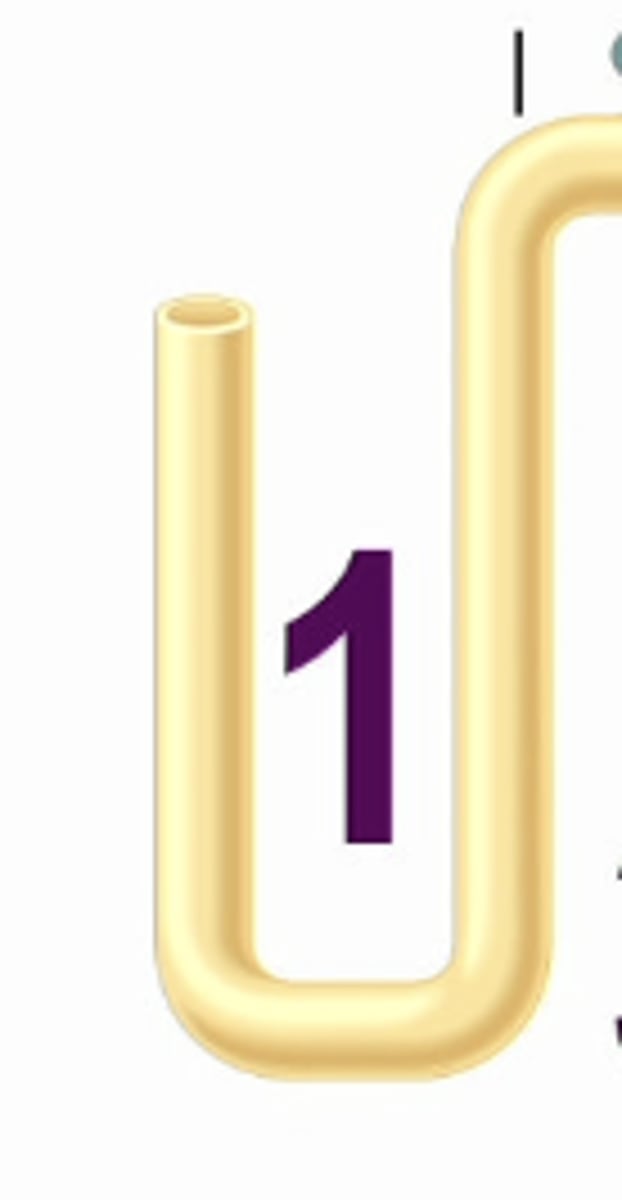
1. descending and ascending segments
2. both freely permeable to water and ions, passive exchange based on osmotic gradients and diffusion
in respect to the vasa recta: capillary: hairpin loop..... what are the requirements for production of concentrated urine?
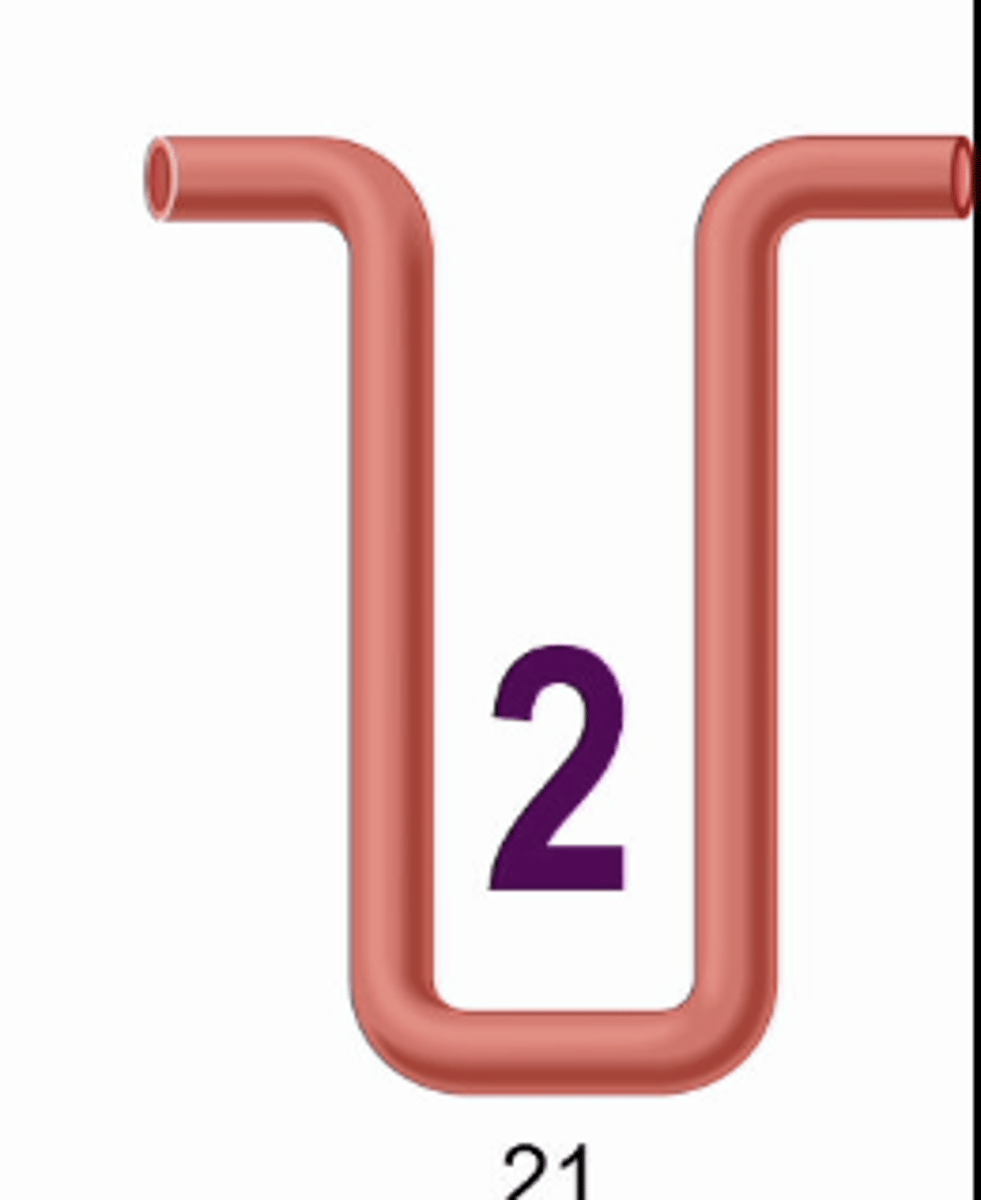
1. serves as osmotic equilibrating device
in respect to the hypertonic medullary interstitium..... what are the requirements for production of concentrated urine?

1. ADH dependent water channels, AQP-2 (aquaporin)
2. passive reabsorption of water
in respect to the antidiuretic hormone..... what are the requirements for production of concentrated urine?

descending loop of henle
NOT permeable to solutes, permeable to H2O
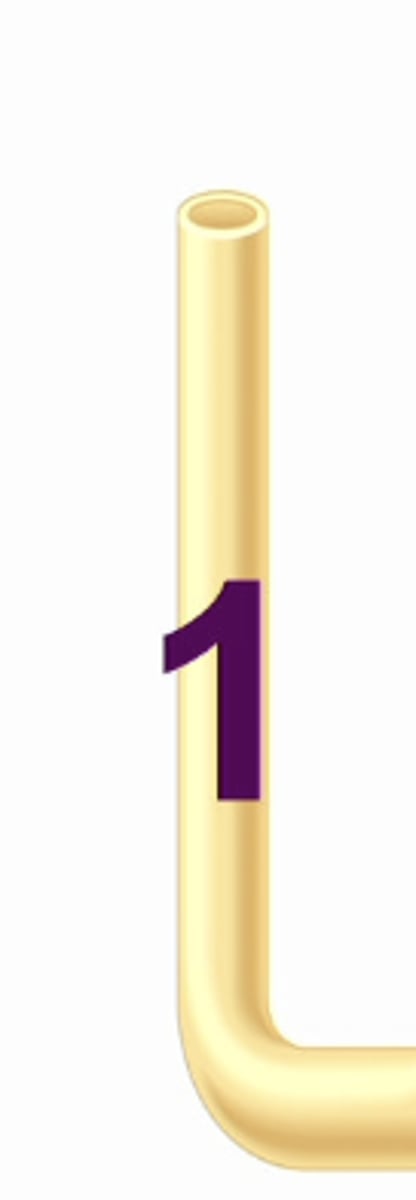
ascending loop of henle
permeable to solutes, NOT H2O

concentrated urine
-generate hypertonic interstitial fluid in confined compartment (renal medulla)
-water permeable tube (collecting duct)
-osmosis to drive water from tubule lumen
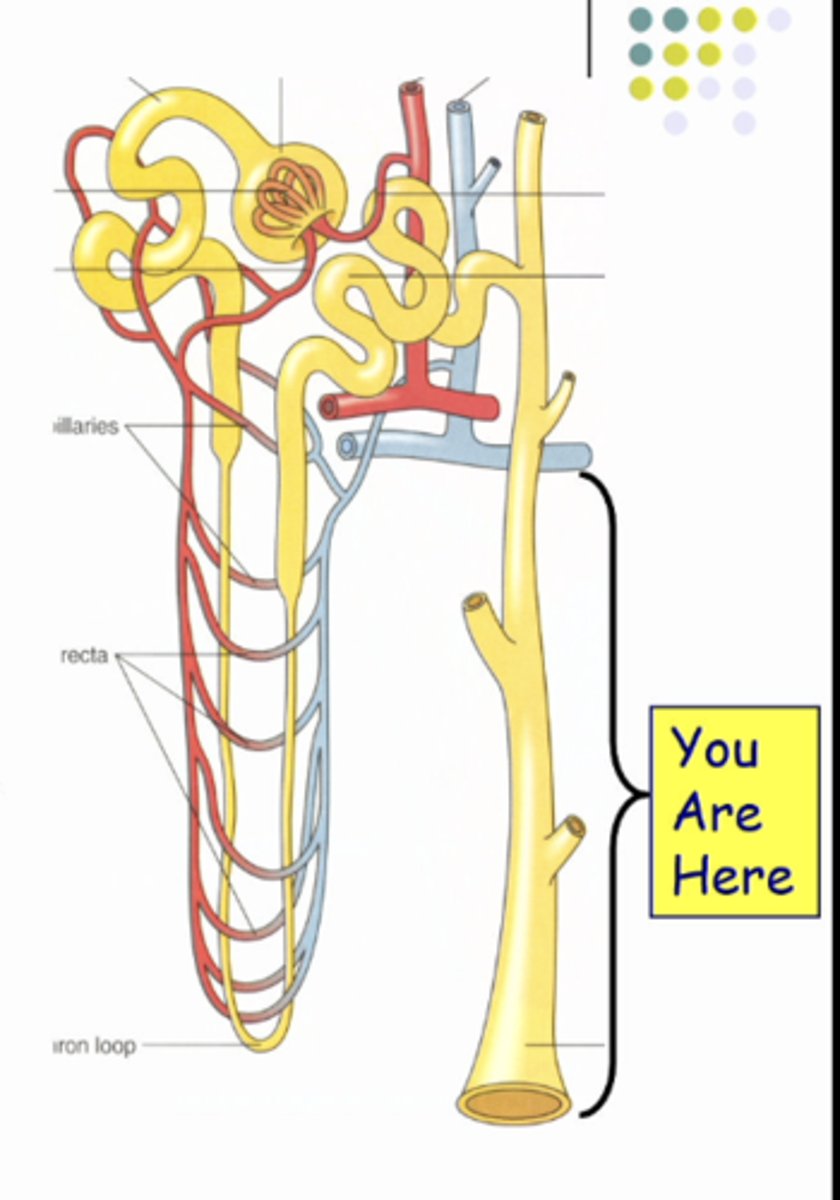
dilute
urine becomes _________ as it movs through ascending limb loop due to Na+ reabsorption and H2O impermeability
1. vasopressin uses cAMP to cause AQP2 insertion into luminal membrane of principle cells of collecting ducts
2. water flows out of tubular fluid of collecting ducts into renal capillaries
3. urine can reach 1200 mOsm (maximum concentration in humans
in order to have a concentrated urine you need.....
increase ADH
osmolality of plasma
if the osmoreceptors detect an increase in plasma osmolality 1%, they will.....
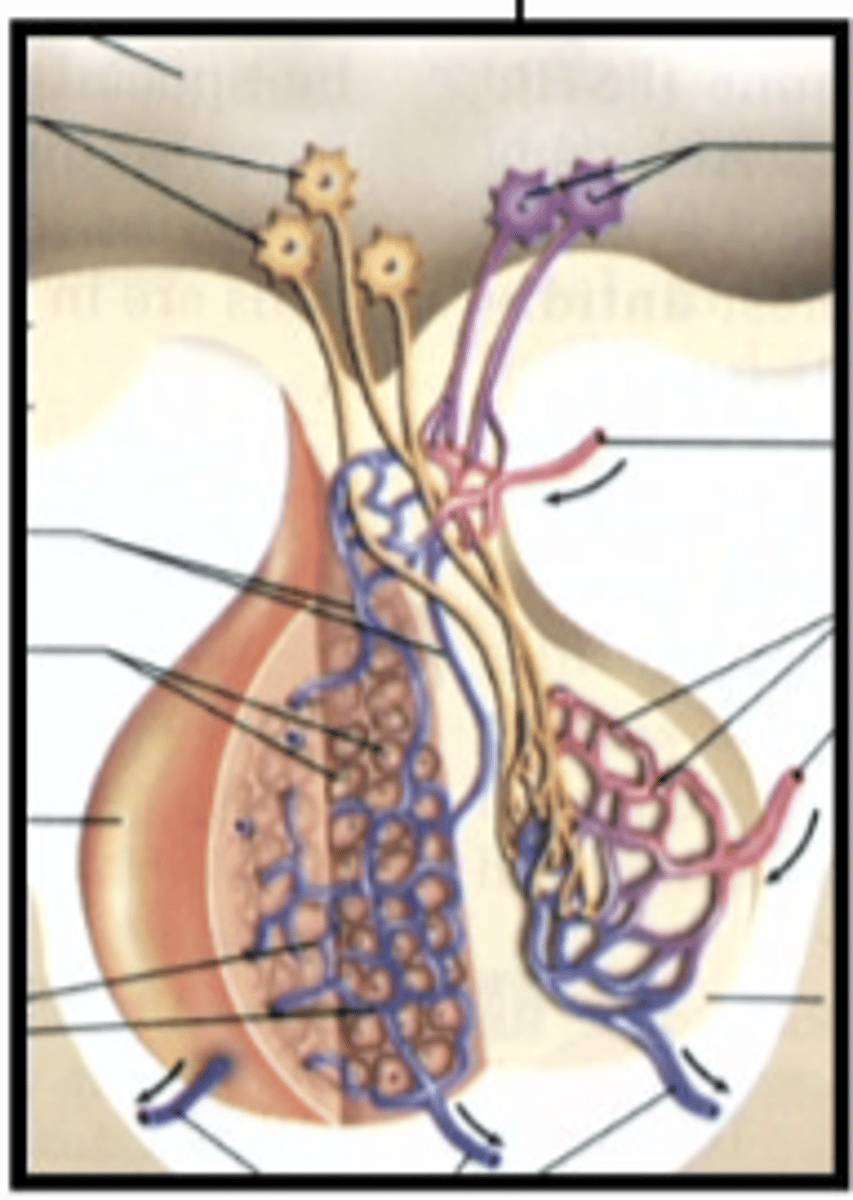
increase ADH
osmolality of plasma
if the baroreceptors sense a decrease in pressure they will....
we are in the final segment of the nephron, the collecting duct epithelial cell. notice there are 2 aquaporins expressed in the basolateral membrane (3 and 4). the kidney expresses 4 different aquaporins (1, 2, 3, 4). aquaporin 3 and 4 are on the basolateral membrane ONLY IN THE COLLECTING DUCT. when vasopressin is circulating in the blood, it will bind to its receptor on basolateral membrane, it is important that the receptor is on this membrane because the hormone is traveling in the blood. when it binds to its receptor it activates adenylate cyclase which converts ATP to cyclic AMP (intracellular signaling molecule). the vasopressin v2 receptor is a g coupled receptor. when the cascade of events is elevated it results in intracellular vesicles containing aqp 2 protein to undergo exocytosis and become an integral part of luminal membrane, when aqp2 is in the vesicle it does nothing!!!!
what is this image showing
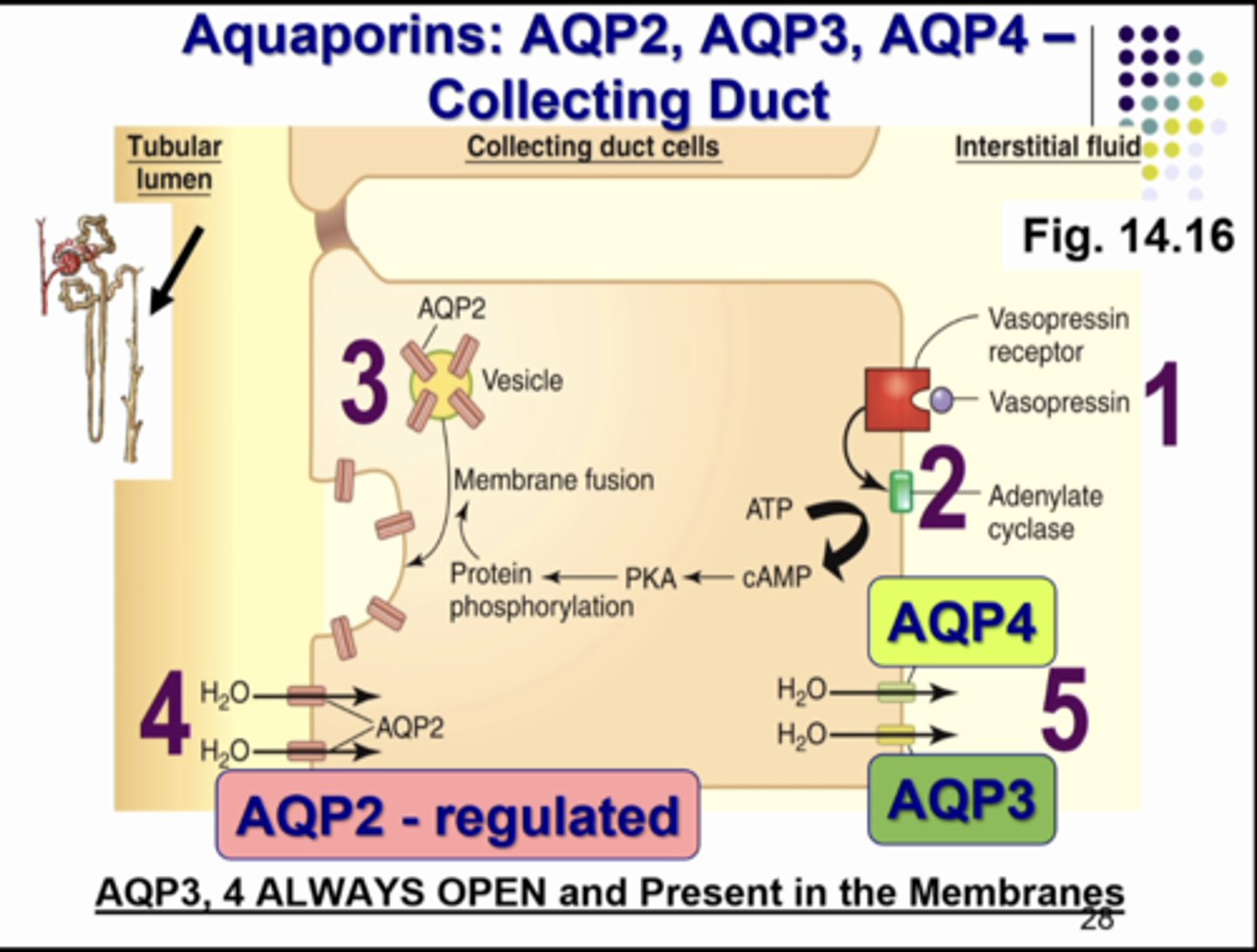
AQP 2, it will change the number of protein in the luminal membrane
the only aquaporin protein that is regulated by antidiuretic hormone is ...
ALWAYS OPEN
AQP 3 and 4 are ____________ _________ and present in the basolateral membrane
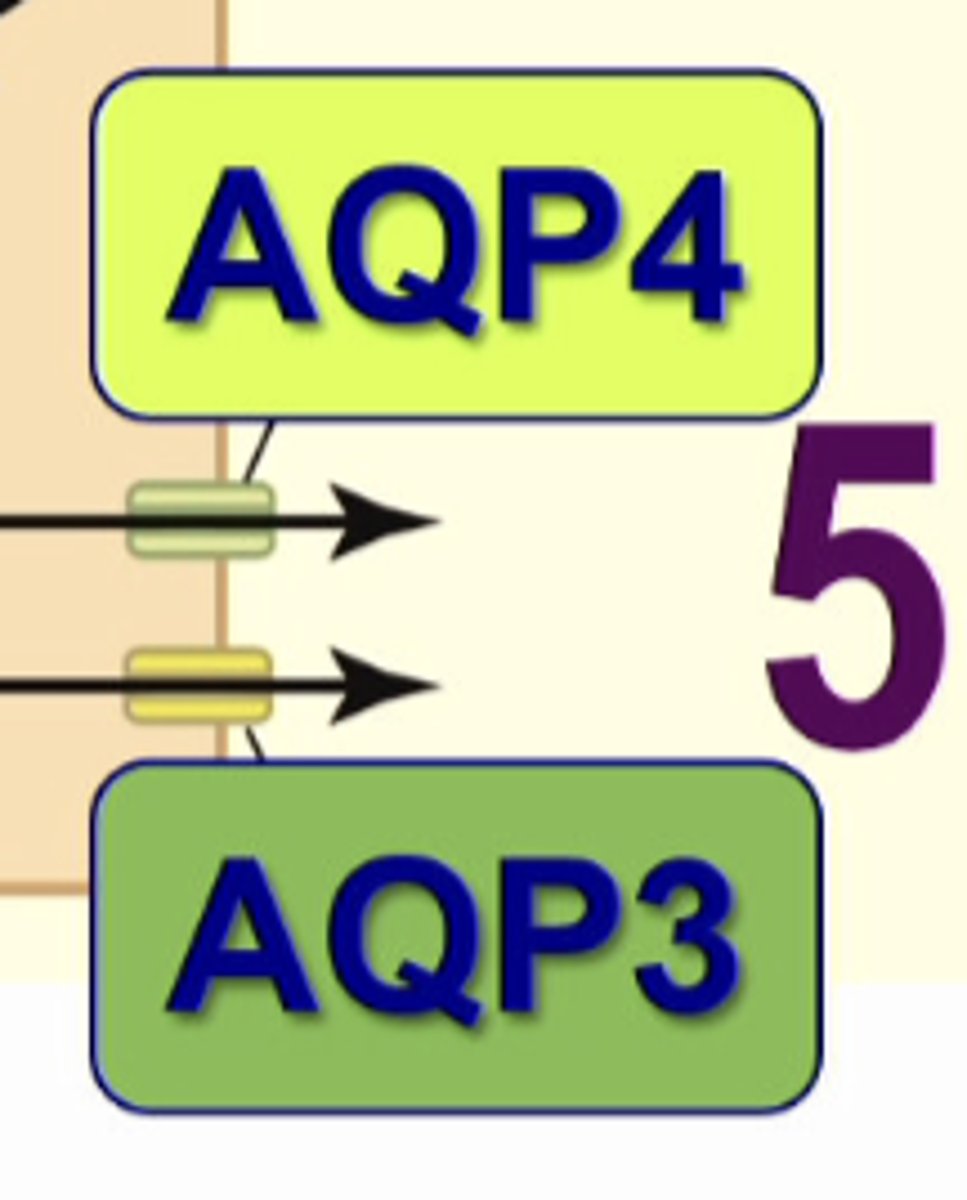
v2 receptor
tubular actions of ADH
AVP/ADH binds to ......... on the basolateral membrane of the collecting duct?
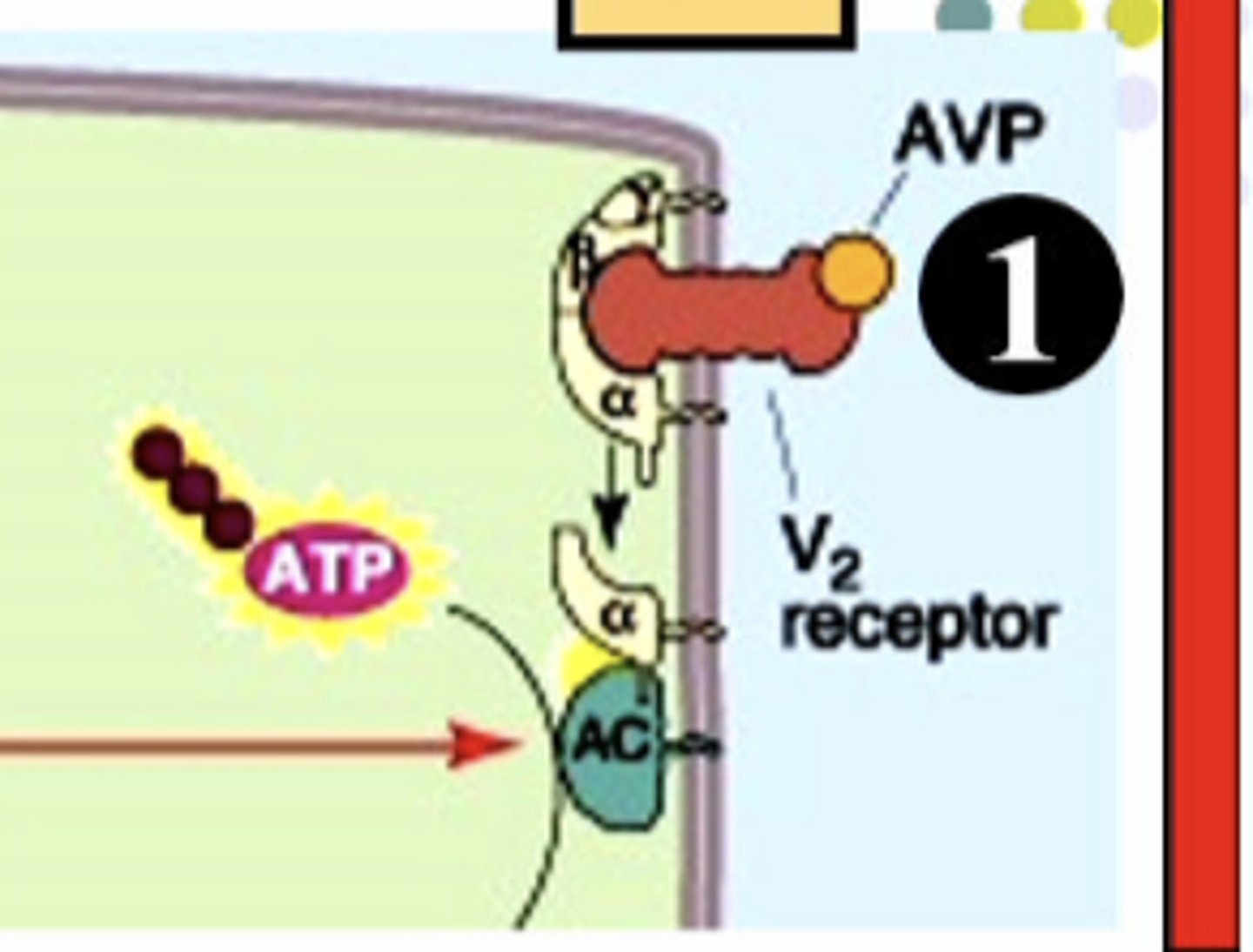
insertion of AQP2 the protein that transports water into the apical membrane which makes the permeability of the collecting duct increase to increase water reabsorption, produce a concentrated urine, and minimize the effects of dehydration of body fluid homeostasis
in response to hormone receptor binding this will result in the ...

undergo an antidiuresis
if you are experiencing a water restriction how can the kidneys fix the problem
undergo an antidiuresis
if you are profusely sweating leading to water restriction, how can the kidneys fix the problem
increased water reabsorption
a high plasma ADH results in....
vasopressin
ADH = .....
the intial stimulus is a decrease plasma volume so low levels of fluid in the extracellular fluid compartment. this low fluid will decrease the blood pressure in the veins, atria, and arteries. the baroreceptors will sense this decrease in pressure and send signals to the brain to increase vasopressin secretion. once the vasopressin secretion is increased... the plasma concentration of vasopressin will increase
what is this image showing... go to the next card for continued explanation
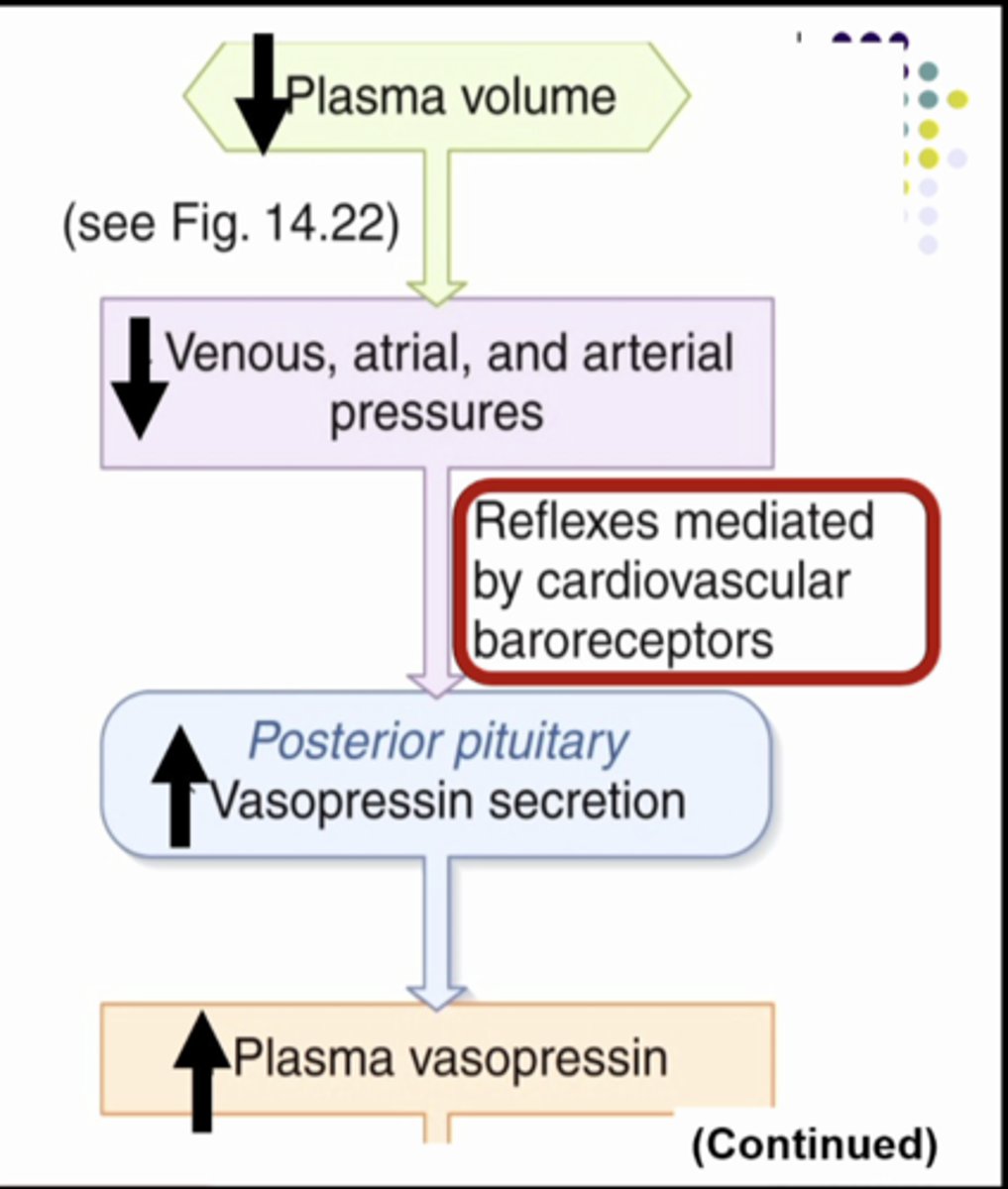
the plasma concentration of vasopressin will increase so the tubular permeability to water in the collecting duct will increase. water reabsorption in collecting duct will increase. water excretion will decrease
SO...
if plasma osmolality is decreased OR blood pressure is low.....
1. signal increase ADH secretion
2. collecting duct will be highly permeable to water
3. you will produce a small volume and concentrated urine
4. you will not change the excretion of sodium, potassium, chloride, or magnesium... it will all stay the same because you are not changing the solute, you are just changing the water
CONTINUED EXPLANATION OF DECREASED PLASMA VOLUME
what is this image showing
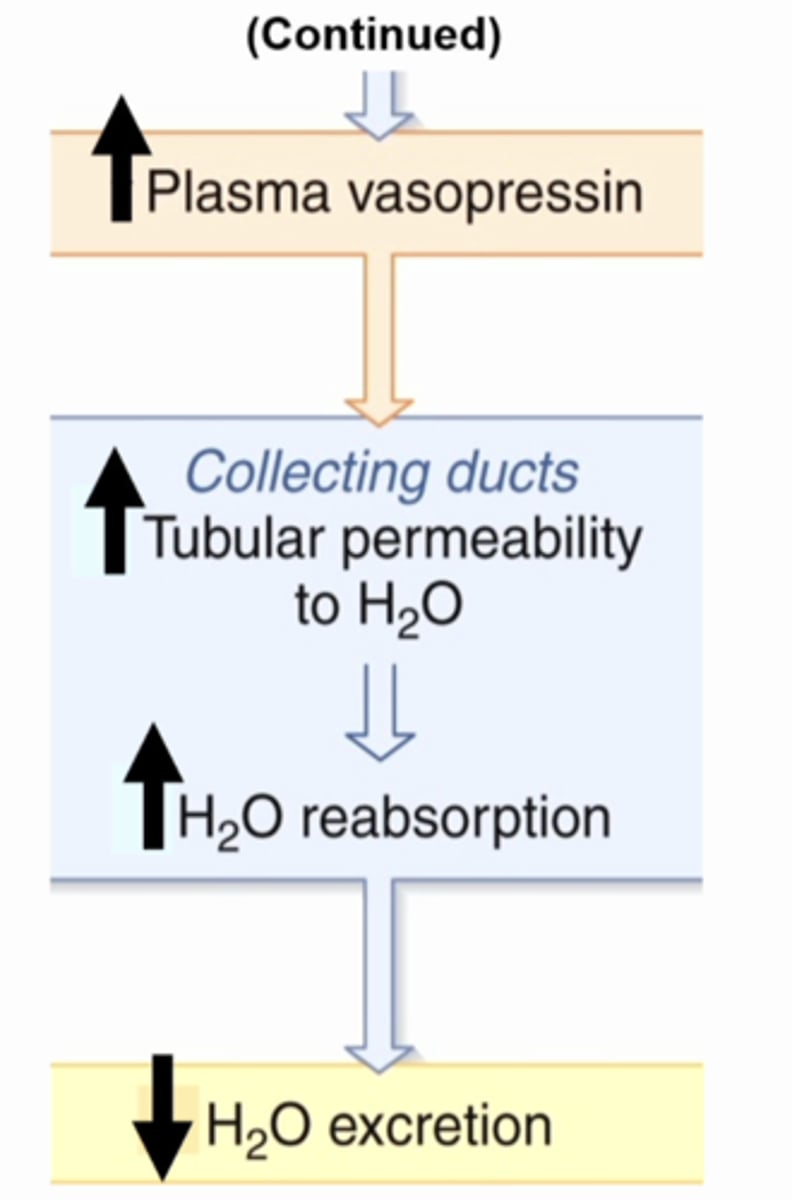
diuresis .... dilute urine
if you have a high water intake what should the kidneys do to fix the problem?
decrease water reabsorption
a low plasma ADH will result in ....
if you have an excess amount of water ingested, the osmolality of the fluid in the body will decrease because you have more water so the sodium is dilute. this will decrease the firing of osmoreceptors. vasopressin secretion will decrease causing the plasma vasopressin to decrease.
what is this image showing? go to the next card for the rest of the explanation!
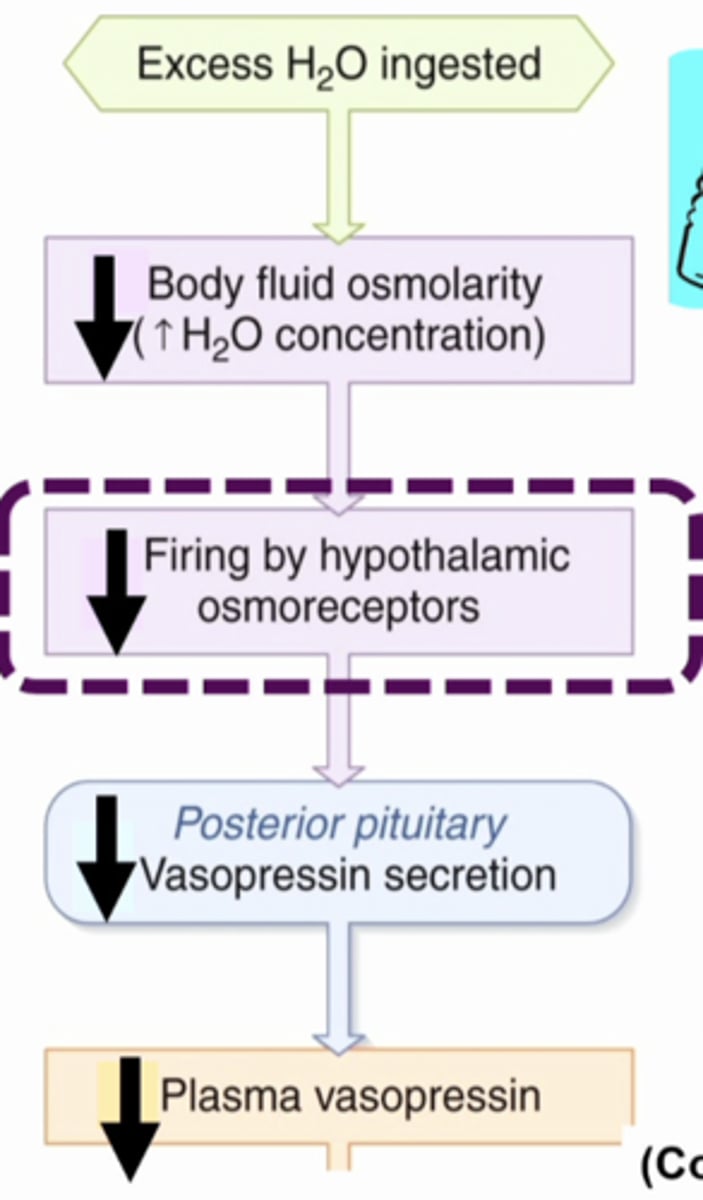
the plasma vasopressin is decreased, so the permeablity to water in the collecting duct will decrease. water reabsoprtion will decrease. water excretion of dilute urine will increase
SO...
1. if you have a decrease in plasma osmolality, you will have a decrease in ADH
2. the collecting ducts will become impermeable to H2O
3. this will create a large volume of dilute urine
CONTINUED EXCESS WATER INGESTION
what is this image showing?
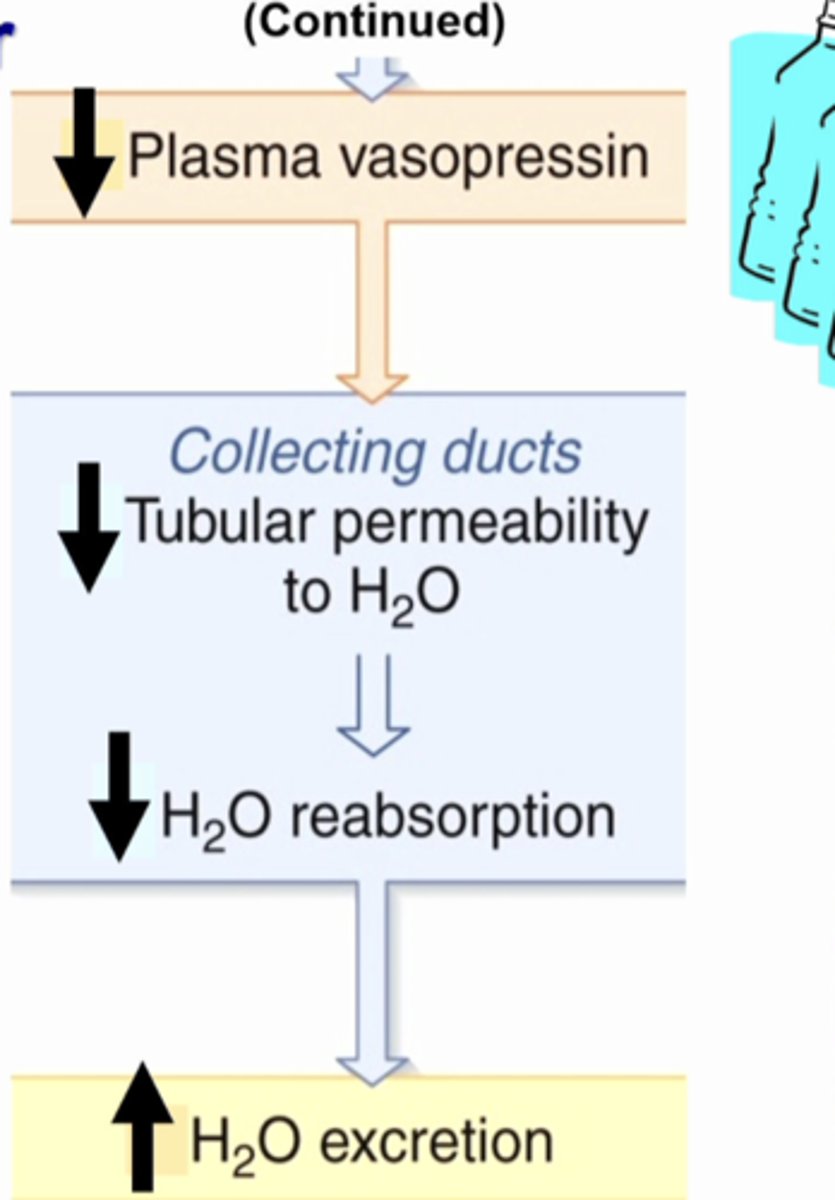
if you are working out a lot in the gym, you will sweat a lot causing a loss of fluid. SWEAT IS HYPO-OSMOTIC TO PLASMA (more dilute than plasma). if plasma is 300 mOSm/L, sweat is about 125mOsm/L... meaning it has more water than salt. the reason sweat tastes salty is because the water has evaporated and the salt has crystalized on your lip... but dont be fooled because sweat is dilute!
in response to severe sweating you will have an increase plasma osmolality because you have lost more water than salt. you will also have a reduction in plasma volume. this will reduce glomerular capillary hydrostatic pressure, which will reduce GFR, which will reduce the filtered load of sodium, and this will contribute to the kidneys ability to reduce sodium excretion. this will decrease blood pressure.
what is this image showing (left side)
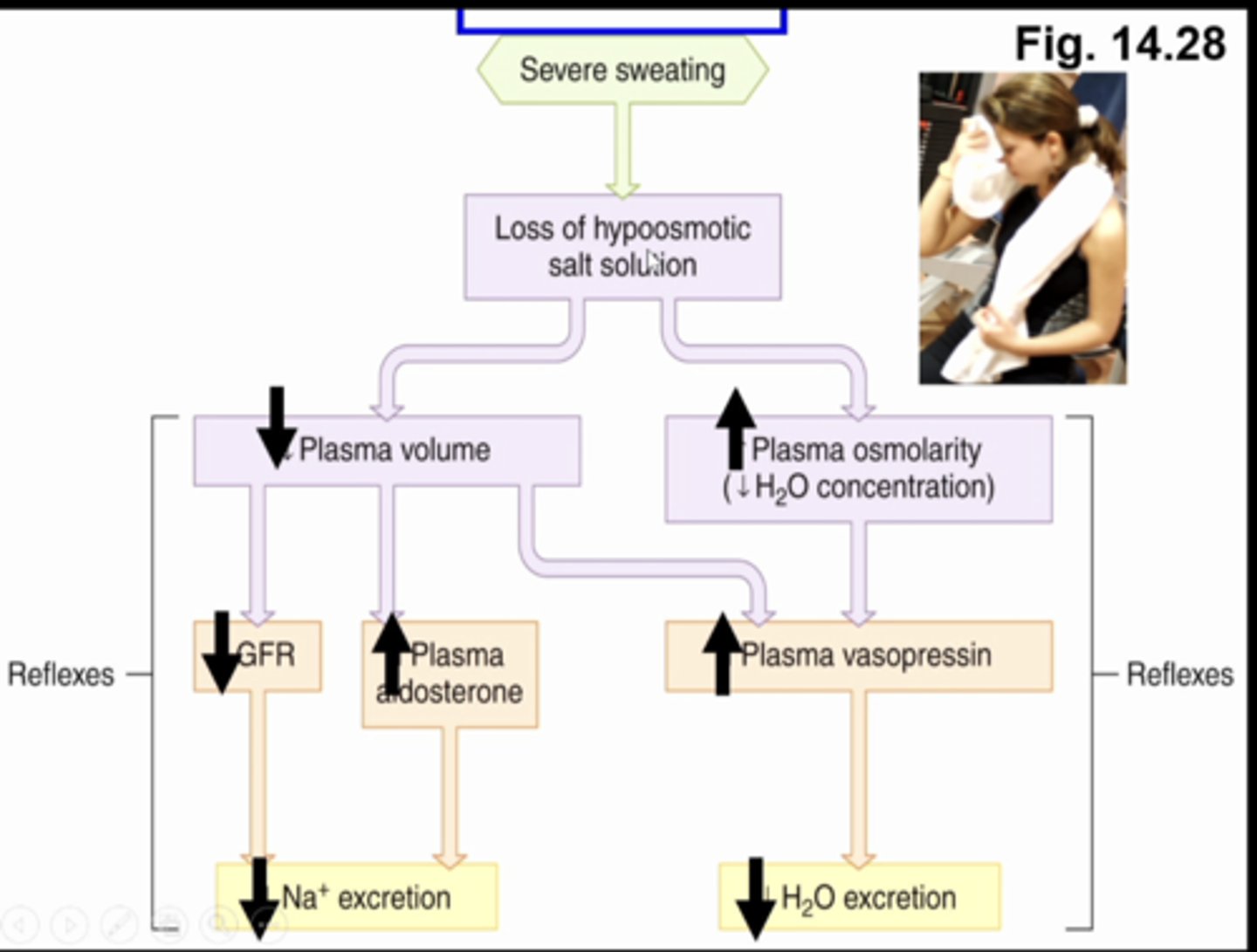
an increase in plasma osmolarity is going to increase plasma vasopressin which will decrease water excretion
what is this image showing (right side)
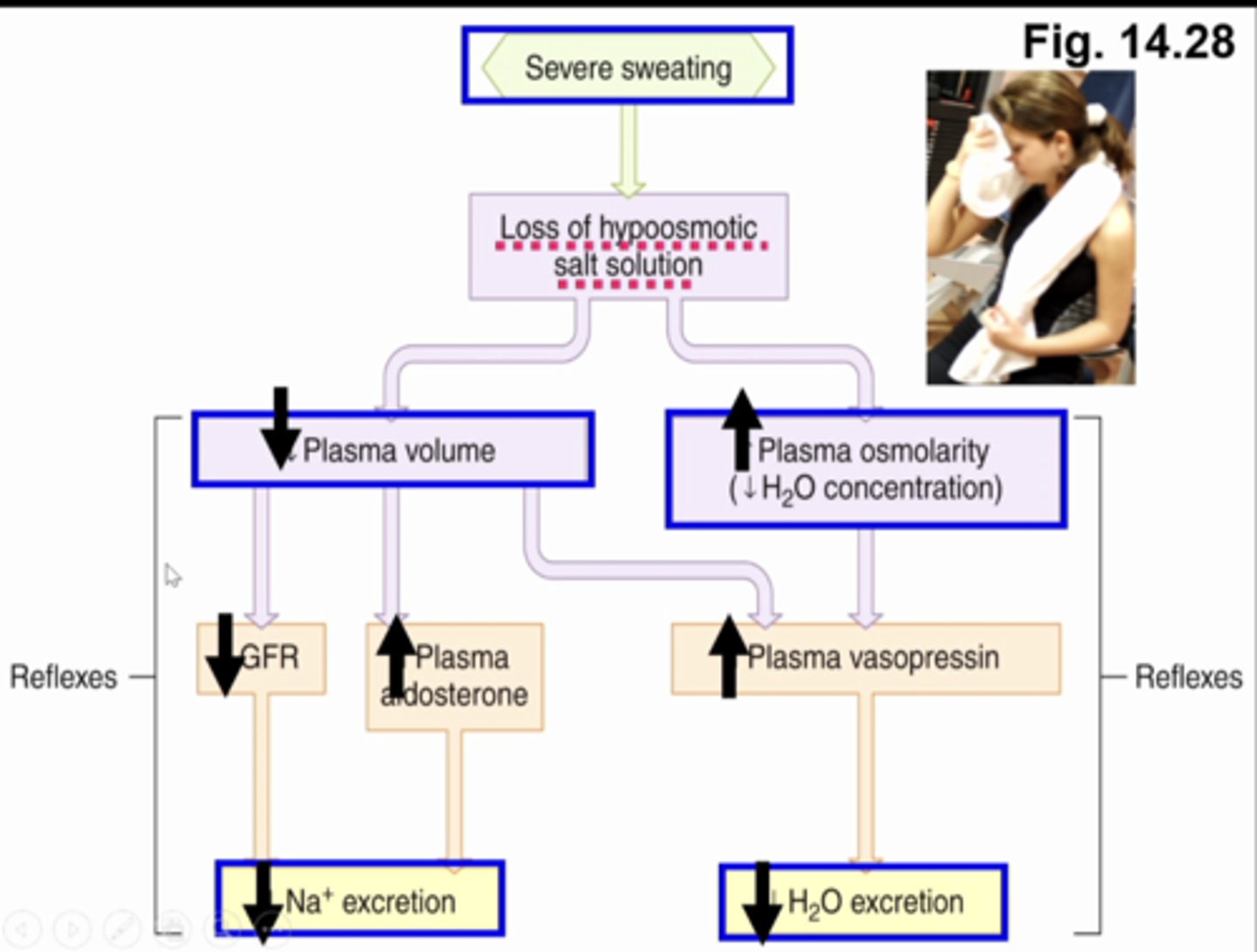
+ = stimulate thirst
- =inhibits thirst
so when there is a decrease in plasma volume and the baroreceptor senses this, they stimulate the thirst center in brain. the baroreceptors and the juxtaglomerular cells of the AA in kidney will increase renin secretion and angiotensin 2. angiotensin 2 in the brain will stimulate thirst.
what is this image showing in respect to decrease plasma volume

it will stimulate the osmoreceptors in the brain, they will stimulate the thirst center in the brain
what is this image showing in respect to increase plasma osmolarity
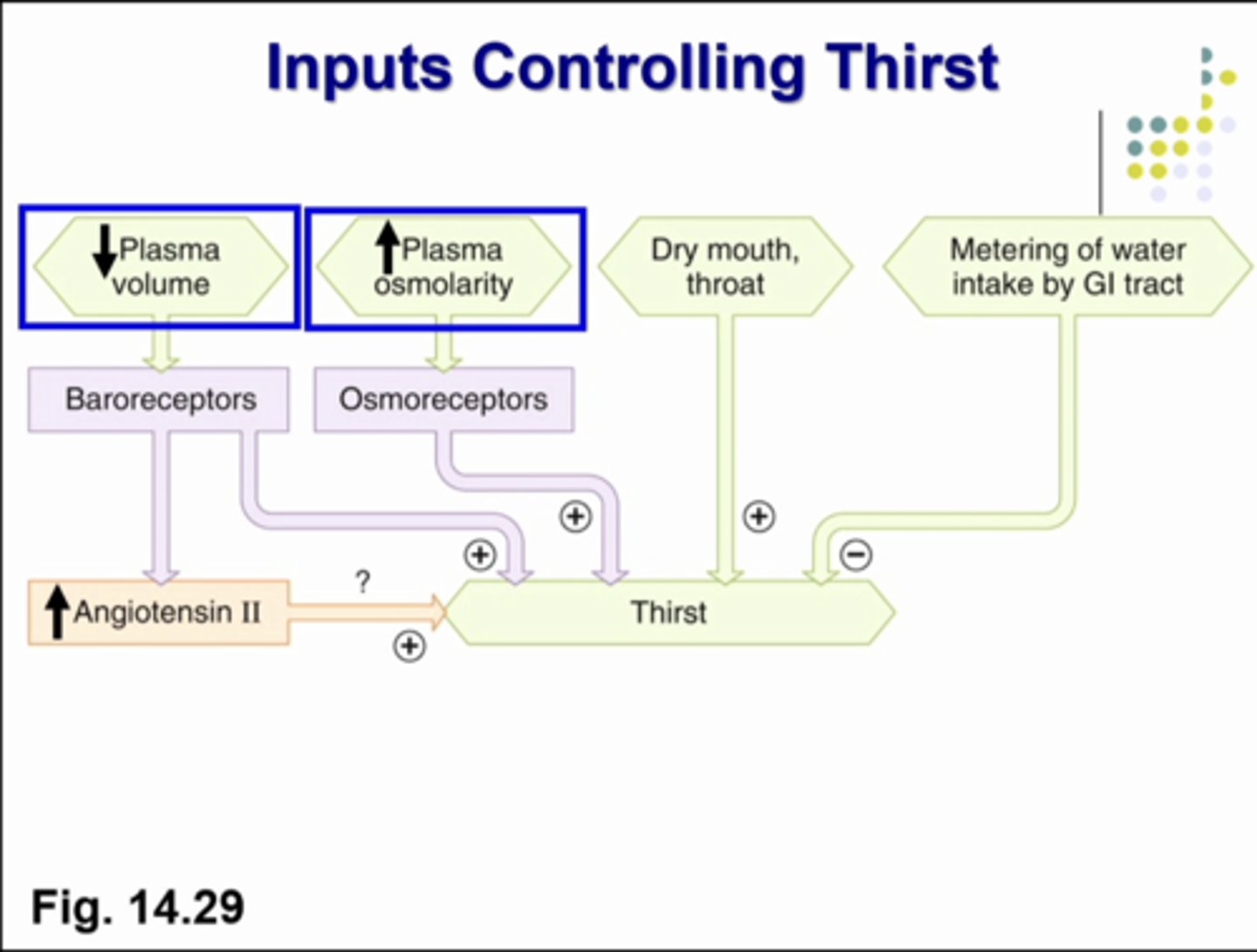
it will signal the brain to increase thirst
what is this image showing in respect to dry mouth, throat
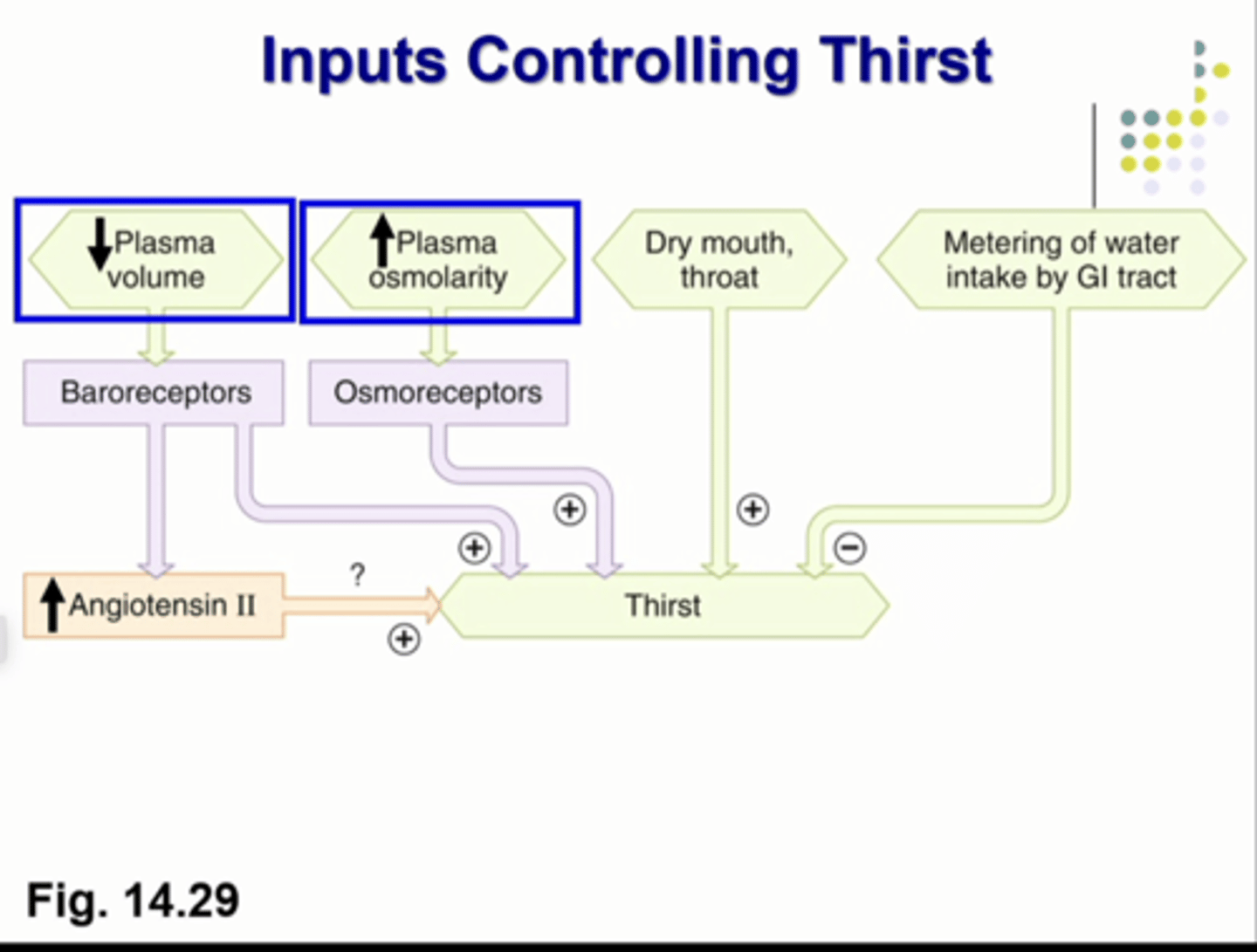
there are "magical" detectors in gi tract that can tell how much water you drink and when you drink a lot of water, and the gi senses it, it will inhibit thirst
what is this image showing in respect to GI tract
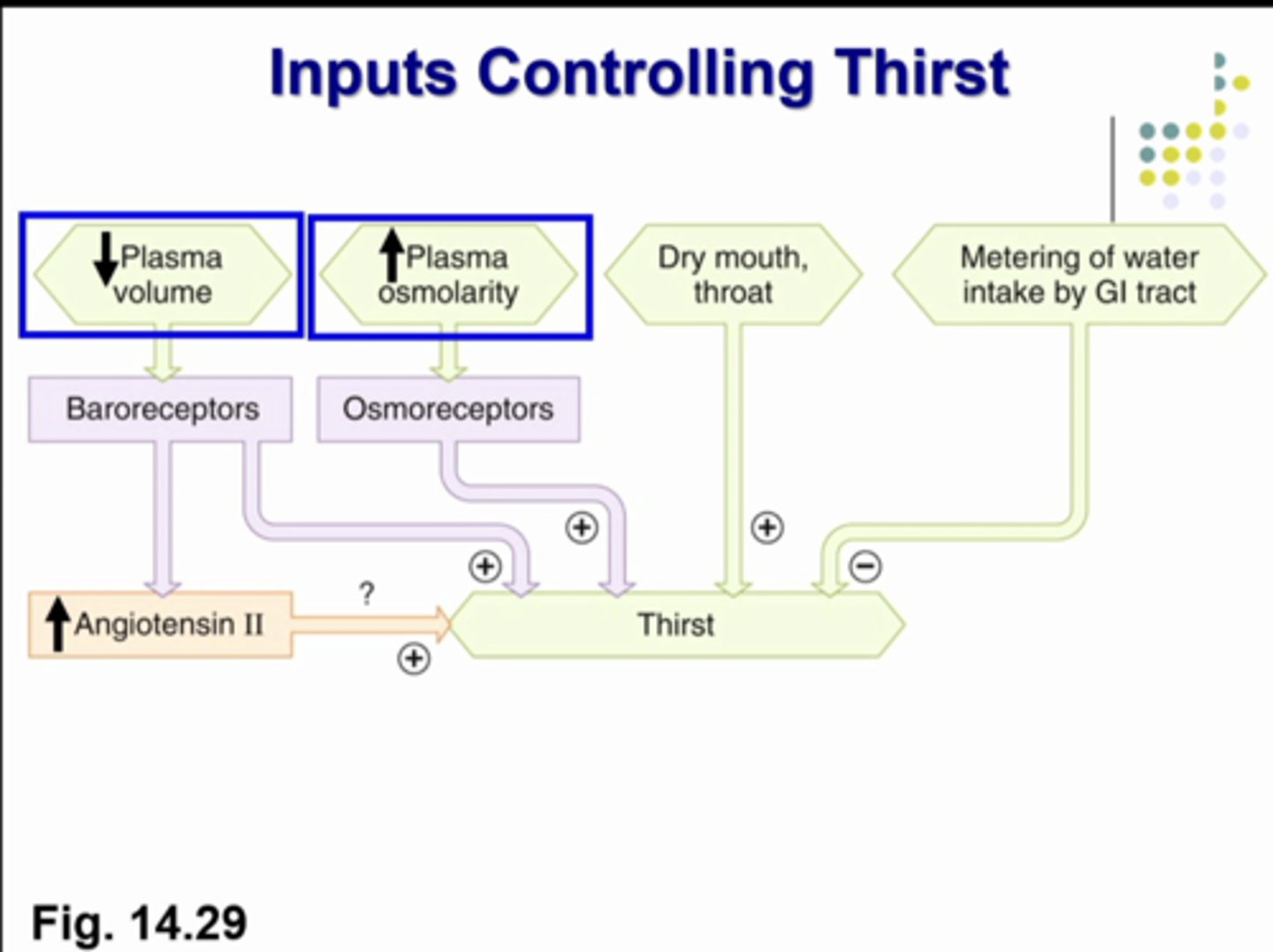
osmoreceptors
most important stimulus for thirst under most physiological conditions
increase plasma osmolality
when you feel thirsty you already have an ....
study tool
study tool
